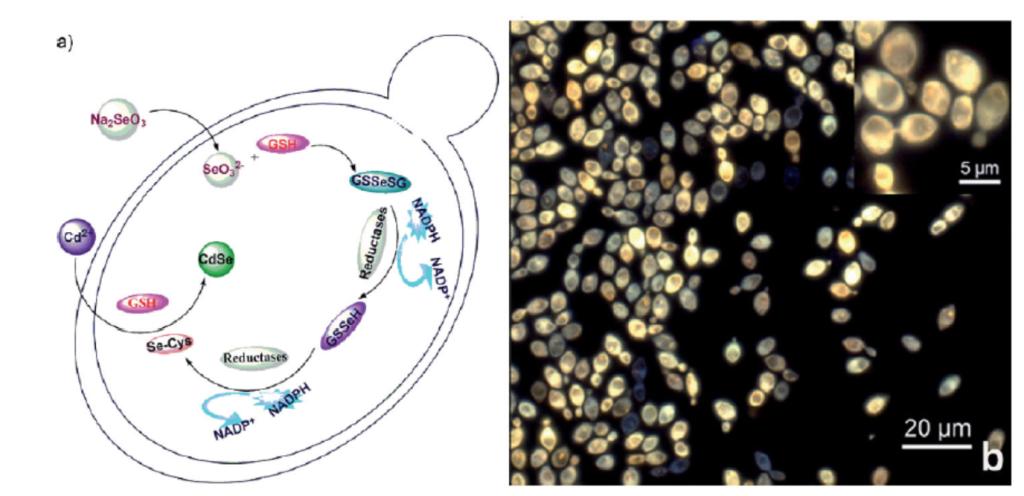Refer to the fluorescence semiconductor nanocrystals less than or close to the mean radius (≲) the exciton Bohr radius of quasi zero dimension (size: 1-20 nm), Quantum dots (QDs) are developed in the seventy s of the 20th century, which have unique fluorescent properties.Compared with traditional fluorescent proteins and organic fluorescent dyes, QDs have the following significant advantages :(1) the fluorescence intensity is very high, nearly 10-100 times higher than that of fluorescent proteins and organic fluorescent dyes, which is very beneficial to improve the detection sensitivity;(2) Good light stability, about 100-1000 times higher than fluorescent proteins and organic fluorescent dyes, very suitable for real-time monitoring into the long time;(3) The wide excitation spectrum and narrow emission spectrum, coupled with the dimension-dependent luminescence property derived from quantum size effect, make it easy to realize monochromatic excitation multicolor emission, which is conducive to multi-color simultaneous labeling detection.Therefore, QDs are widely used in the field of cell biology, biochemistry, immunology and other subjects for labeling and imaging. Existing traditional element organic synthetic route - metal compounds can get high quality naked semiconductor nanocrystals, however, are usually adopted extremely dangerous and expensive inflammable and explosive toxic organic reagents such as Cd (CH3)2, Zn (CH3)2, and need in anhydrous anaerobic under 300 ℃ high temperature. Even so, it is difficult to satisfy the requirements of being super small, perfectly structured and biologically compatible at the same time, so its comprehensive performance is often not ideal.
In order to solve the problem of controllable synthesis and performance regulation of fluorescent QDs for high-quality biomarkers, our group developed a new approach to solve the problem of precise control of chemical reaction process involved in the preparation of QDs and other markers by using the robust and precise regulation mechanism of biological system. For this, we put forward "complex in time and space coupling cell instead of the biochemical reaction of natural biochemical reactions controllable synthesis of nano tag" of "spatio-temporal coupling control living cell synthesis strategy", skillfully using yeast cell, just by a simple chemical operation, control of intracellular biochemical reactions to different direction, we are expecting to realize the complex synthetic reaction inside living cells cannot occur naturally, successful in controllable synthesis of semiconductor CdSe multicolor fluorescence QDs. We reduced the reaction temperature from commonly used about 300 ° C (oil phase chemical synthesis CdSe) to only 30 ° C (temperature of cell culture), and without any inflammable, explosive, toxic solvents, operating a cumbersome dangerous chemical evolution of simple cell culture, and effectively will be a few minutes of rapid synthesis process slowed to a few hours or a few hours of extremely slow process, given the size and nature of the regulation with enough space, can obtain high quality in living cells glow of CdSe nanocrystals, and can be controlled and convenient to get green, yellow, red and so on particle size uniformity of fluorescence QDs.【Adv. Funct. Mater., 19(2009)2359-2364; ACS Nano, 7(3)(2013)2240-2248; Small, 10(4)(2014)699-704】
Then, the strategy was successfully extended from fungi system (yeast) to system of bacteria (staphylococcus aureus), implements the bacterial cells in situ synthesis CdS0.5 Se0.5 luminescent quantum dots and efficiently (almost 100%) the bacteria cells into a "light" and "shiny" implementation "self" fluorescent functional cells, produce "identical" light emitting cells (beacon) as a tracer element fluorescent tags.【ACS Nano, 8(5)(2014)5116-5124】Recycling natural on the surface of the cell walls of staphylococcus aureus staphylococcus aureus, A protein and antibody specificity combined with Fc side, by changing different antibodies, can be convenient and efficient build size uniform, monodisperse, fluorescence intensity, stable performance, all sorts of specificity of ultrasensitive fluorescence labeled antibody probe, successfully detected avian influenza H9N2 virus, pseudorabies virus, baculovirus, salmonella SPP., and breast cancer cells.
Furthermore, it has been successfully extended to mammalian cell systems of great biomedical significance, such as human breast cancer cells McF-7, MDA-MB-231 and MDCK cells. At the same time, through elaborate design, in time and space coupling cell metabolism and detoxification pathways and new cells formed process of micro vesicles, makes cells according to the design completed intracellular fluorescence QDs synthesis and direct source cell labeling in situ micro vesicles, implements the QDs synthesis and living cells in situ tag fusion, can be directly collected good fluorescence micro vesicles, method, moderate and efficient markup efficiency can be as high as 94.8%.【Sci. China Chem., 63(4)(2020)448-453】The significance of this work is not only to enable cells to automatically complete synthesis and labeling, but also to expand the horizon of synthetic biology.
The principle of "living cell synthesis" of QDs is extended to a cell-free simulation system, and a new method of "quasi-biosynthesis" is proposed.【JACS, 134(1)(2012)79-82; JACS, 138(6)(2016)1893-1903】The control problems of ultra-small, biocompatible (no toxic heavy metals, water dispersible, renal excretion, etc.), multifunctional complex structure and fluorescent quantum water phase synthesis of biomarkers have been solved.

FIG. Intracellular biosynthesis roadmap of fluorescent CdSe quantum dots (a) and subcellular localization image of intracellular fluorescence (b)
Attachment Download: